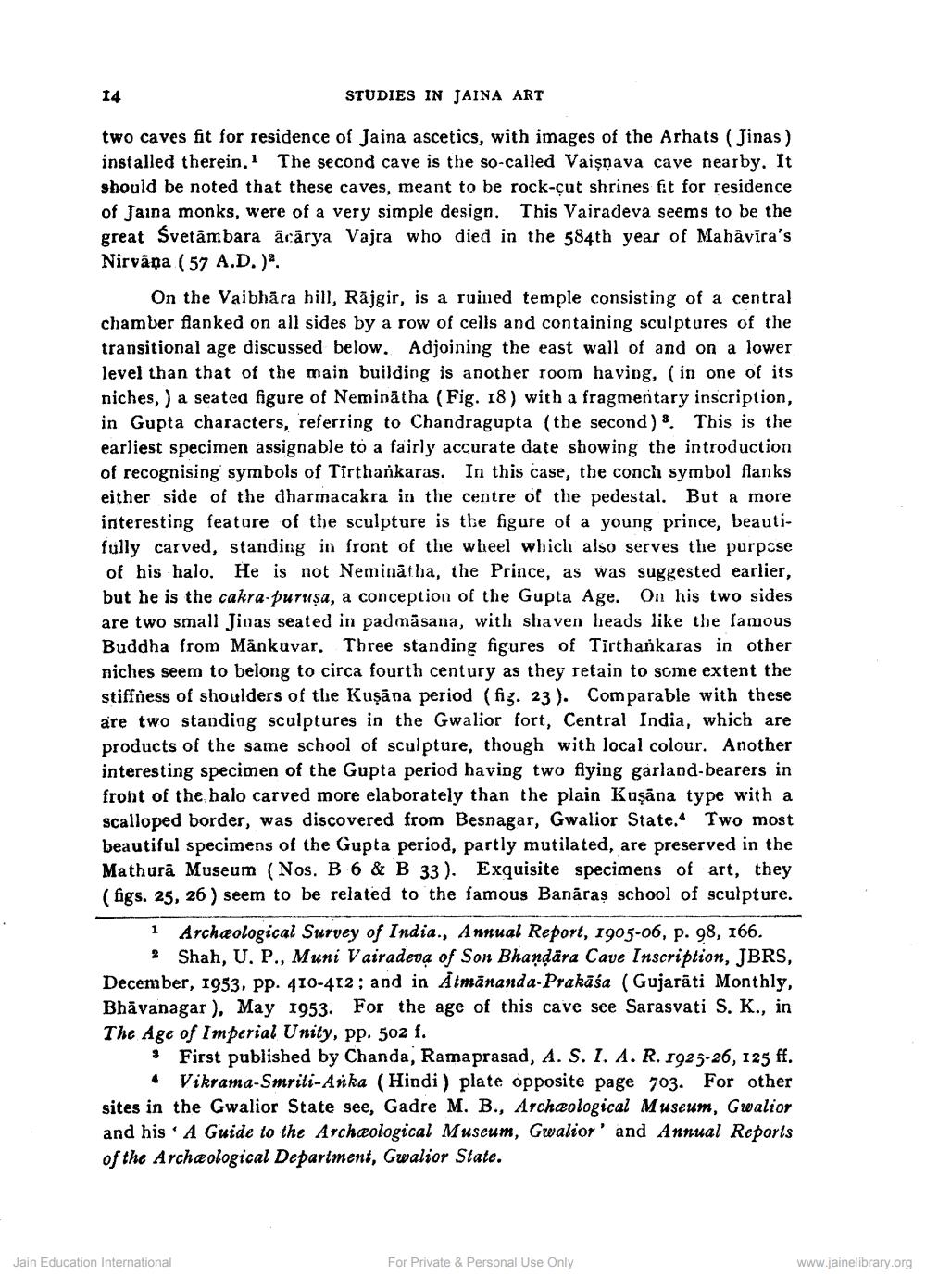________________
14
STUDIES IN JAINA ART
two caves fit for residence of Jaina ascetics, with images of the Arhats (Jinas) installed therein. The second cave is the so-called Vaisnava cave nearby. It should be noted that these caves, meant to be rock-cut shrines fit for residence of Jaina monks, were of a very simple design. This Vairadeva seems to be the great Svetambara ācārya Vajra who died in the 584th year of Mahavira's Nirvāņa (57 A.D.).
On the Vaibhāra hill, Rājgir, is a ruined temple consisting of a central chamber flanked on all sides by a row of cells and containing sculptures of the transitional age discussed below. Adjoining the east wall of and on a lower level than that of the main building is another room having, (in one of its niches, ) a seated figure of Neminātha (Fig. 18 ) with a fragmentary inscription, in Gupta characters, referring to Chandragupta (the second) This is the earliest specimen assignable to a fairly accurate date showing the introduction of recognising symbols of Tirtharikaras. In this case, the conch symbol flanks either side of the dharmacakra in the centre of the pedestal. But a more interesting feature of the sculpture is the figure of a young prince, beautifully carved, standing in front of the wheel which also serves the purpose of his halo. He is not Neminātha, the Prince, as was suggested earlier, but he is the cakra-puruṣa, a conception of the Gupta Age. On his two sides are two small Jinas seated in padmāsana, with shaven heads like the famous Buddha from Mänkuvar. Three standing figures of Tirthankaras in other niches seem to belong to circa fourth century as they retain to some extent the stiffness of shoulders of the Kuşāna period (fig. 23). Comparable with these are two standing sculptures in the Gwalior fort, Central India, which are products of the same school of sculpture, though with local colour. Another interesting specimen of the Gupta period having two flying garland-bearers in front of the halo carved more elaborately than the plain Kuşāna type with a scalloped border, was discovered from Besnagar, Gwalior State. Two most beautiful specimens of the Gupta period, partly mutilated, are preserved in the Mathurā Museum (Nos. B6 & B 33 ). Exquisite specimens of art, they (figs. 25, 26 ) seem to be related to the famous Banāras school of sculpture.
1 Archeological Survey of India., Annual Report, 1905-06, p. 98, 166.
2 Shah, U, P., Muni Vairadeva of Son Bhandara Cave Inscription, JBRS, December, 1953, pp. 410-412 ; and in Atmananda-Prakāśa (Gujarati Monthly, Bhāvanagar), May 1953. For the age of this cave see Sarasvati S. K., in The Age of Imperial Unity, pp. 502 f.
8 First published by Chanda, Ramaprasad, A. S. 1. A. R. 1925-26, 125 ff.
• Vikrama-Smrili-Anka (Hindi) plate opposite page 703. For other sites in the Gwalior State see, Gadre M. B., Archeological Museum, Gwalior and his ' A Guide to the Archæological Museum, Gwalior' and Annual Reports of the Archæological Department, Gwalior State.
Jain Education International
For Private & Personal Use Only
www.jainelibrary.org




